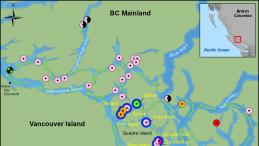Emergency closure of five open net-cage salmon farms required to protect migrating salmon
Vancouver, B.C. – Five open net-cage salmon farms must be permanently removed from a salmon migration route in the northern Georgia Strait in order to protect thousands of juvenile salmon from sea lice and other potentially fatal diseases, the Coastal Alliance for Aquaculture Reform said Tuesday.
“The Wild Salmon Narrows, along the east and north side of Quadra Island, is a significant migration route for juvenile wild salmon from local rivers, the Fraser River, and in all likelihood, Washington and Oregon runs as well,” says Ruby Berry of Georgia Strait Alliance.
“It is imperative that the five open-net cage farms be removed from this narrow migration channel as an emergency measure to protect these critical salmon runs from the unnecessary risk posed by the open net-cage farms,” Berry said.
Thousands of salmon are currently traveling from British Columbia’s rivers to the ocean as part of their annual out-migration. There is mounting evidence that out-migrating Fraser River salmon, some of which belong to endangered stocks, are infected with sea lice and may be put at risk from fish farms in the region.
CAAR is calling on the federal and provincial governments to take immediate action to protect the area’s marine resources by removing open net-cage farms and by making a significant investment in commercial-scale closed containment for B.C. The coalition has devoted years of effort to fostering constructive change and to engaging in dialogue with industry and government. But governments and industry are failing to take substantive action and B.C.’s wild salmon, marine ecosystems and coastal communities continue to suffer from the impacts of open net-cage salmon farming. “Industry has dragged its feet on transitioning to closed containment far too long, and while the government delays, wild salmon populations are being impacted by sea lice,” David Suzuki Foundation’s Corey Peet says. “No other region in the world is risking so many stocks of wild salmon with net pen salmon farms.”
The rich biodiversity of the Wild Salmon Narrows attracts many recreational tourists and provides local jobs that can only be sustained if wild fish and the marine ecosystem remain healthy.
“Wild salmon are being impacted by open net-cage salmon farming and commercial fishermen’s livelihoods are being threatened,” says David Lane of the T. Buck Suzuki Environmental Foundation. “B.C. commercial fishermen and fish plant workers shouldn't be losing out while a handful of Norwegian multinationals rake in profits from their farmed salmon feedlots. “
CAAR also demands that the four inactive tenures at the south end of this channel be relinquished.
-30-
Background
Years of scientific research has built a global body of evidence that clearly shows open net-cage salmon farms cause ecosystem harm everywhere they are located.
CAAR is demanding the removal of the five active open net-cage salmon farms located in the Wild Salmon Narrows to the east and north of Quadra Island, in order to reduce the risk of sea lice infection to out-migrating juvenile salmon.
Thirty open net-cage salmon farm feedlots choke the north end of the Georgia Strait and one of the narrowest pathways is the Wild Salmon Narrows, along Okisollo and Hoskyn Channels, east and north of Quadra Island.
The farms to be removed are:
- Venture Point, Mainstream/Cermaq
- Brent Island, Mainstream/Cermaq
- Barnes Bay, Greig Seafood
- Cyrus Rocks, Marine Harvest
- Sonora-Okisollo, Marine Harvest
Altogether, these farms are licensed to produce 15,300 metric tonnes of Atlantic Salmon during every 18 to 22 month production cycle, discharging tons of waste into the fragile marine environment of the Wild Salmon Narrows and acting as reservoirs for sea lice that infect wild salmon.
In addition, there are four Marine Harvest inactive tenures in Hoskyn Channel, at the south end of Wild Salmon Narrows, which must also be relinquished.
Juvenile sockeye in the northern Georgia Strait are being infested with sea lice:
- Preliminary results of genetic analyses have confirmed the predominance of Fraser River populations in samples of juvenile sockeye salmon caught near salmon farms in this area.
- Approximately 60% of the sockeye sampled in 2007 and 99% in 2008 were from the Fraser River.
- 30 Fraser River stocks (sub-populations) were identified in total were found to be primarily Chilko, Shuswap and Quesnel Lake, and included Adams Lake and endangered Cultus Lake salmon.
- Studies of parasite infection levels (sea lice) on juvenile wild salmon in the Northern Georgia Strait region have shown that they repeatedly hosted more sea lice near farms than far from farms.
Detailed information and sources: Sea Lice and Salmon: A Science Primer
The Wild Salmon Narrows is a highly productive area of magnificent ecological significance and is at risk of devastating impact from open net-cage salmon farms. The abundant natural marine life being put at risk in this area include rockfish, ling cod, scallops, crab and herring as well as the extensive clam gardens of Wiaitt Bay. The whole region is located within Rockfish Conservation Areas.
There are at least eight wild salmon bearing rivers within this narrow channel.
Recreational tourists flock to the area, creating many local jobs. The abundance of the region has supported large populations of First Nations for thousands of years.
Commercial fishing is of great importance in the area, including salmon, ground fish, prawns and urchin fisheries.
All open net-cage farms must be removed from marine waters and moved to closed containment in order to protect the wild salmon and marine environment. CAAR is demanding the removal of open net-cage salmon farms starting in the Wild Salmon Narrows.

